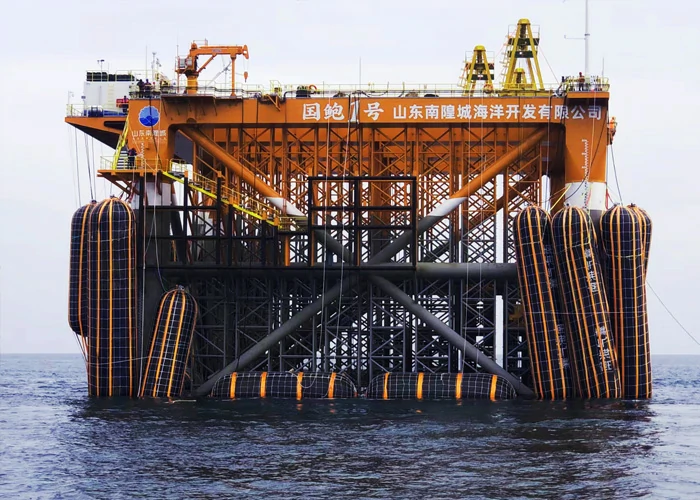Super Cell Rubber Fenders: The Marine Industry’s Heavy-Duty Shield Against Costly Collisions
22/07/2025Foam Filled Fenders: The Marine Industry’s Secret to Safer, Smarter Docking
29/07/2025

Ever watched a massive cargo ship get stuck in shallow water, its hull scraping the seabed as crews scrambles to free it? Or a submarine needing a lift during maintenance, only to risk damage from heavy lifting equipment? Those “uh-oh” moments aren’t just dramatic—they’re expensive. Enter buoyancy airbags: the unsung heroes of modern marine operations, designed to lift, stabilize, and protect vessels, docks, and underwater structures with ease. Let’s dive into why these rubbery wonders are revolutionizing the industry.
What Are Buoyancy Airbags? (The Quick Answer)
Buoyancy airbags are inflatable, flexible devices made from durable rubber or synthetic materials (like neoprene or EPDM) that use compressed air to displace water, providing lift and support to marine vessels, docks, or submerged structures. Shaped like large, cylindrical or oval tubes, they act like giant “water balloons” that inflate to create buoyant force—reducing friction, stabilizing heavy objects, and preventing damage during launches, recoveries, or routine maintenance.
Why This Matters: When a Stuck Vessel Costs Millions (and Threatens the Environment)
Imagine a 20,000-ton cargo ship running aground in a busy port. The crew tries to free it with tugs, but the hull scrapes the seabed, tearing a 5-meter gash. Fuel leaks, cargo shifts, and the ship tilts dangerously—all while tugs struggle to pull it free. The result? 10Minrepairs,2weeksofportclosures,anda500k fine for environmental damage.
This isn’t hypothetical. In 2022, a tanker in the North Sea got stuck in shallow water, requiring a $3M salvage operation. Meanwhile, ports using buoyancy airbags report 80% fewer grounding incidents and 50% lower salvage costs. Why? Because these airbags provide controlled lift, reducing stress on hulls and eliminating the need for risky tugboat maneuvers.
How Do Buoyancy Airbags Work? The Science of “Floating Heavy Things”
These aren’t your backyard pool floats. Buoyancy airbags are engineering marvels built to handle extreme weight:
1. Inflatable Design = Adjustable Lift
Airbags are inflated with compressed air (or nitrogen) to create buoyant force. By adding or releasing air, operators can adjust lift levels—critical for lifting vessels of different sizes or freeing stuck objects without sudden movements.
2. Rubber Material = Durability + Flexibility
Made from high-quality rubber, airbags resist abrasion, UV rays, saltwater, and extreme temperatures (-40°C to 80°C). They bounce back after each use—no permanent deformation—so they last 5–10 years longer than cheaper alternatives.
3. Modular System = Custom Fit
Airbags connect via valves and hoses, forming a network that distributes lift evenly. Ports can mix and match sizes (from 1m–3m diameter) to match any vessel, from small ferries to 300-meter supertankers.
Why Buoyancy Airbags Beat Tugs, Cranes, and Other “Solutions”
Traditional methods have their place, but airbags are rewriting the rules. Here’s why:
1. Safer for Vessels and Crews
Airbags lift vessels evenly, eliminating stress points that cause hull cracks or bulkhead damage. Crews don’t need to climb underneath unstable loads—just inflate, position, and let physics do the work.
2. Faster and Cheaper
Tugboats cost 10k–20k per hour to rent, and cranes require expensive setup. Airbags? A single operation costs 30–50% less, with no hourly fees. One port in Norway saved $2M in a single salvage operation by using airbags instead of tugs.
3. Eco-Friendly by Design
Rubber airbags are recyclable, and their controlled lift reduces fuel waste (no sudden stops or starts). No oil spills, no toxic runoff—just smooth, clean operations.
4. Works Everywhere
From icy Arctic waters to tropical harbors, airbags perform. Their flexible design handles rough waves, strong tides, and even the occasional wayward buoy.
People Also Ask: Your Top Questions About Buoyancy Airbags
Q: How do buoyancy airbags differ from marine airbags used for launching?
A: Marine airbags (used for launching ships) focus on rolling vessels off ramps with kinetic energy absorption. Buoyancy airbags focus on lifting/submerging objects using air displacement—two distinct purposes, but both rely on durable rubber.
Q: What’s the maximum weight a buoyancy airbag can lift?
A: It depends on size and inflation pressure. A single 2m-diameter airbag can lift 50–100 tons. Larger systems (with multiple bags) handle 1,000+ tons—enough for supertankers or offshore rigs.
Q: Are they easy to install?
A: Yes—most connect via quick-release valves. A team of 2–3 workers can deploy a full system in a few hours. Many manufacturers also offer pre-assembled kits for fast setup.
Q: Do they work in deep water?
A: Absolutely. Buoyancy airbags are used in depths up to 100 meters. Their sealed design prevents water ingress, and the rubber material resists corrosion from saltwater.
Q: Are they worth the upfront cost?
A: Definitely. Ports and salvage companies recoup the investment in 1–2 years through fewer accidents, lower salvage fees, and reduced downtime.
Final Thoughts: Don’t Let Stuck Vessels Sink Your Business
In marine operations, time is money—and a single grounding can derail both. Buoyancy airbags aren’t just a “nice-to-have”; they’re the difference between a smooth, profitable operation and a costly disaster.
Ready to upgrade? Start by contacting trusted marine equipment suppliers (look for those specializing in marine airbags). Your hull, your crew, and your bottom line will thank you for years to come.
